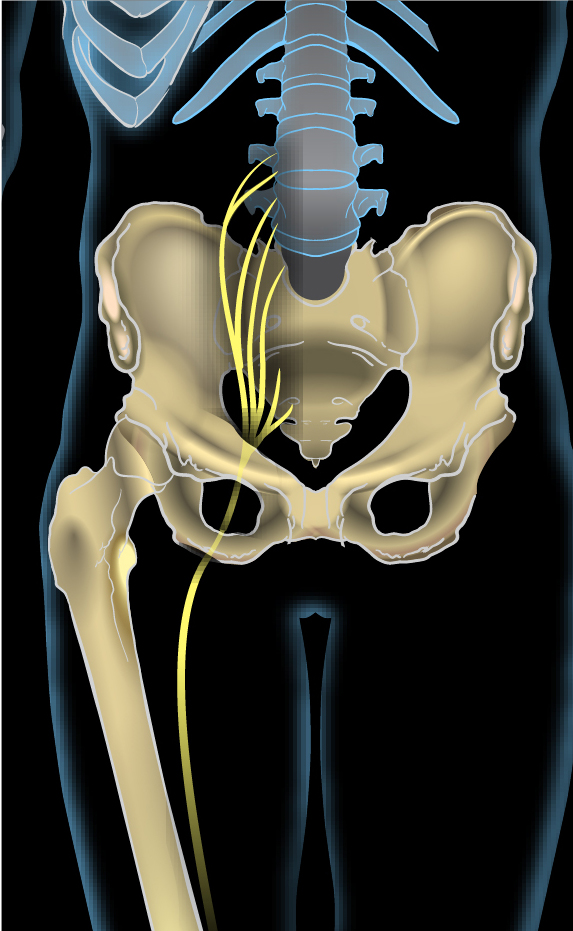Nerve Mobilization…

The sciatic nerve is seen emerging into the buttock/gluteal region. Permission Joseph E. Muscolino. Manual Therapy for the Low Back and Pelvis – A Clinical Orthopedic Approach (2015).
Can a “tight” sciatic nerve restrict ankle joint range of motion? If so, nerve mobilization technique should be effective toward increasing dorsiflexion of the ankle joint.
Dorsiflexion Range of Motion
It is commonly believed that maximal ankle joint range of motion (ROM) into dorsiflexion is restricted by the tension within the plantarflexor muscles (e.g., gastrocnemius, soleus, tibialis posterior, flexors digitorum and hallucis longus, fibularis longus and brevis). But any soft tissue, not just muscle/tendon myofascial tissue, can be taut, resulting in decreased joint ROM. The problem is that the influence of these non-muscular/myofascial tissues on joint ROM has not been much studied.
Past Studies Point to Sciatic Nerve Stiffness
Two past studies observed a remarkable decrease in the maximal ankle joint ROM into dorsiflexion when the hip joint was flexed from the neutral position to 90°. Because there is no plantarflexor muscle that crosses both the hip and ankle joints, these results have suggested that non-muscular structures may play a role in the limitation of maximal ankle joint ROM in dorsiflexion. A possible explanation is that the sciatic nerve that extends from the spine into the foot, if taut, could limit ankle joint dorsiflexion.
Comment by Joseph Muscolino – What about a Myofascial Meridian?
There might not be any plantarflexor muscle that crosses the knee and the hip joints, but there is a continuum of myofascial tissue that does. Named by Tom Myers as the Superficial Back Line Myofascial Meridian (Anatomy Train), there is continuity from the plantar fascia to the epicranius of the head, including the gastrocnemius and hamstrings along the way. It is certainly possible that flexing the hip joint could place a stretch on the hamstrings that would then exert tension on the gastrocnemius, which could then restrict dorsiflexion of the ankle joint. However, the study cited in this blog post article did take this into consideration and ruled out that there was any increased stiffness in the gastrocnemius.
Digital COMT
Did you know that Digital COMT (Digital Clinical Orthopedic Manual Therapy), Dr. Joe Muscolino’s continuing education video streaming subscription service for massage therapists (and all manual therapists and movement professionals), has at present (November of 2018) more than 1,000 video lessons on manual therapy continuing education, including entire folders on massage, stretching, and joint mobilization. And we add seven (7) new videos lessons each and every week! And nothing ever goes away. There are also folders on Anatomy and Physiology, including an entire folder on Cadaver Anatomy… and many, many more on other manual and movement therapy assessment and treatment techniques. Click here for more information.
Study
A study published in Scientific Report determined whether a static stretch aimed loading the sciatic nerve (nerve mobilization of the sciatic nerve) without stretching the plantarflexors can:
- alter the stiffness of the sciatic nerve
- increase dorsiflexion ROM of the ankle joint.
Fifteen healthy volunteers (age: 22 ± 3 years) participated in this study. Passive maximal ankle joint ROM into dorsiflexion was assessed with the hip flexed at 90°. Sciatic nerve stiffness was estimated using an instrument called shear wave elastography.

Results
The results showed that sciatic nerve stretching (nerve mobilization of the sciatic nerve) decreased stiffness of the sciatic nerve by 13.3 ± 7.9% and increased dorsiflexion of the ankle joint by 6.4 ± 2.6° when assessed in the hip-flexed position. In addition, the decrease in sciatic nerve stiffness was significantly correlated with the change in maximal ankle joint ROM into dorsiflexion. These effects occurred in the absence of any change in gastrocnemius (medial head) and biceps femoris (of hamstring group) stiffness.
Conclusion
The authors speculated that the change in nerve stiffness after the stretching session was due to the viscoelastic behavior of nerve which can explain an acute decrease in stiffness while being stretched. In other words, peripheral nerves, such as the sciatic nerve, are sheathed in connective fascial tissue and can be stretched (mobilized) and lengthened. These results demonstrate that maximal ankle joint dorsiflexion ROM can be acutely increased by nerve mobilization stretching technique of the sciatic nerve.
Comment by Joseph Muscolino – Nerve Mobilization Technique
A study like this is important because it provides evidence-based proof that there is efficacy to the treatment technique known as nerve mobilization. This should not come as a surprise because all soft tissues have viscoelastic property, meaning that they can be shorter or longer, looser or stiffer. Which means that any soft tissue, including peripheral nerves, if taut (locked short) could restrict joint ROM. Therefore, any treatment technique that can increase nerve mobilization would accordingly have the potential to increase joint ROM.
This blog post article was created in collaboration with www.terrarosa.com.au.
(Click here for the blog post article: How Do We Assess / Diagnose a Client with Sciatica?)
Digital COMT
Did you know that Digital COMT (Digital Clinical Orthopedic Manual Therapy), Dr. Joe Muscolino’s continuing education video streaming subscription service for massage therapists (and all manual therapists and movement professionals), has at present (November of 2018) more than 1,000 video lessons on manual therapy continuing education, including entire folders on massage, stretching, and joint mobilization. And we add seven (7) new videos lessons each and every week! And nothing ever goes away. There are also folders on Anatomy and Physiology, including an entire folder on Cadaver Anatomy… and many, many more on other manual and movement therapy assessment and treatment techniques. Click here for more information.

